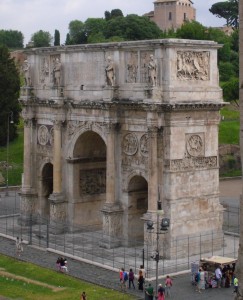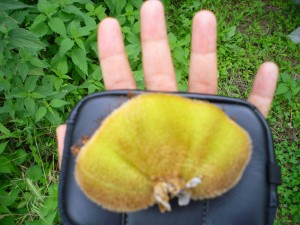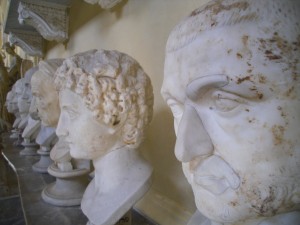
Constantine’s Arch – seen from the Colosseum. Built for him by the Roman Senate to say, “Hey, thanks for kicking Maxentius’ ass for us.”
Arguably, if it weren’t for one man’s bizarre dreams, most of the western world might still be worshiping Pagan and Roman gods. But Constantine did dream vividly, did afterward stick “X”s all over his army’s gear, did defeat his foe, and did later beat the U.S. founding fathers to the punch in the “religious freedom” department by… one thousand four hundred years. Oh yeah, and he said, “Okay, everyone. I’m going to be a Christian now.”
Many say that Constantine’s Rome is the ancient seat of today’s modern world, which I think anyone with a cell phone or internet access should probably care about at least a little. It’s sort of like D.C. to Americans, only with a few thousand more years of history.
So how is Rome? Well, green, first of all. Of course a massively important civilzation wouldn’t have survived without fertile soil, but I failed to expect verdant countryside. My vision of dry, scrubby, southern-California-ish scenery died stubbornly.
I came to be on Roman soil thanks to a farm internship in Corese Terra — once an outpost on a medieval Roman “highway.” (A road we later experienced in the farm’s hilarious “quattro per quattro”— basically a 4WD Honda Civic hatchback.) Farm partner and manager Pompilio is a lively high-school ag teacher who spends half his days on the farm and half at home with his family and students. His farm parter, Rosa, is an 80 year old woman who is going to live forever. Not only did she work right alongside us in the kiwi vineyard, not only does she drive with the precision of an overtasked road warrior, but I even saw her run. She’s also Pompilio’s mother. You can imagine this dynamic was nothing short of hilarious. That is, when we understood what they were saying. Which was less than half the time. Because neither of them speak English!
In making plans to visit, when my half Italian-half English email was answered in all Italian, I said, “Umm… if you don’t speak any English, don’t you think we’ll have a hard time learning anything from you?” I desciphered Pompilio’s response to be, roughly, “Nah… it’ll be fine. We just had some Malaysian people here and they don’t speak any Italian or French.” Umm…. huh? Okay. Pompilio’s easy-going, can-do attitude, along with the knowledge he makes a living teaching things I want to learn, sold me. I’m happy to report no hindsight regrets!
New items in the knowledge store house:
-

Chernobyl Kiwi! Thanks to the market’s resistance to irregularity, we pluck and toss these beasts to the ground.
Nettles are a sign of soil fertility,
-
A smell that common weeds sometimes emit when split open also indicates fecundity
-
Fruits farthest from the trunk grow most slowly thanks to decreased water pressure
-
Lightning bugs aren’t nocturnal. In the sunshine, these feijoa-flower-loving bugs aren’t very beautiful. At night, they are mating before bed. Oh, and when in worm stage, these beetles-to-be can’t control their glow.
-
Fish refuse can be used to make insect traps. Plastic soda bottles hung on trees with fish smell wafting out attract flies that would otherwise infest the olives and kiwis. Once inside, the bugs have a hard time escaping.
-

Delicious feijoa’s (NZ gave me my first intro to this amazing fruit!) come from these lovely flowers.
Use of “okay” in every day speech is a result of battle-record-keeping in the American Civil War (0 K = zero killed)
-
In a 3 x 3 grid of kiwis, one male plant in the center is enough to ensure pollination of the surrounding trees.
-
One can make thousands of dollars worth of super-strength fertilizer using mostly free items — whey, fresh ruminant poo, ash, yeast, and sugar. Anyone want the recipe?
Before learning to make the Godzilla of plant food, we spent a behemoth of a day in Rome.
Between seeing the Colosseum, Roman Forum, Spanish steps, Trevi Fountain, Vatican, Piazza Navrona, and Pantheon we squeezed in some rest for our feet at cafes. I gawked often at the huge number of young priests all over the city. Our dinner stop in the highly regarded “typical” Trestevere neighborhood had us seated next to a chatty couple from none other than Rapid City, South Dakota! I spent countless hours of my youth in Rapid — it had the shopping mall nearest my Wyoming hometown — so it feels like a second home to me. Small world!
Impressive is an understatement for the Colleseum and Pantheon — built without the aid of microprocessors and still standing! I fell in love with the Trevi Fountain. The colors reminded me of Sicily, and the marble statues all elegantly lord over a constant swarm of tourists. Piazza Navrona is among the few European squares that are fully in use (i.e. not just vast expanses of lonely cobblestones surrounded by pretty buildings), so it got my vote. The Vatican was… different than I expected.
Firstly, being the smallest independent state in the world and supposedly having better security than the POTUS, I thought I would know exactly when I was entering and leaving. No. There are walls in areas, but some borders are wide open and blending with Rome. Also, the word “city” in “Vatican City” implies that there might be some streets with houses or shops. It would be more adequately termed “Vatican Park” or “Vatican Estate” – a large expanse of green, with a main complex of buildings and a bunch of smaller buildings scattered amongst the foliage.
The tourist schtick in regards to “seeing the Vatican” actually means seeing the Vatican Museum. It’s like the Smithsonian, except it’s not free: definitely more exhibits than the average person would care to look at in a single day. Its floor plan can be likened to cattle chutes, forcing all the tourists to flow toward the exit. Memories:
-
The display respectfully praising aboriginal religion in Australia impressed me.
-
Art maintenance and restoration is largely funded by American Catholics. 60% of the patron acknowledgements were for American groups. The other 40% were divided piecemeal among other locations in the world.
-

The heavenly glare was unintentional. But isn’t this so much nicer than the drab, lifeless paintings from the days of yore?
I discovered I like restored art! The aged stuff is dark and depressing, while the bright colors in rejuvenated paintings give me hope that maybe that period in history isn’t as somber as it seems.
-
The Sistine Chapel looks like a school gym decorated for a dance. And is generally so full of tourists it feels like an overcrowded prom. It’s narrow, long, and there are no enclaves, columns, domes, or varying ceiling heights like most Catholic religious spaces. It’s just a big, rectangular room in the bowels of the Vatican. And Michaelangelo’s coup-de-gras painting, “The Creation of Adam,” isn’t highlighted in any way. Yes, it’s in the middle, but its size leaves it looking like just another a panel in a fresco comic strip. All the Vatican guards march around yelling for everyone to shut up and respect this sacred space already. The din drops a few decibels for about thirty seconds. Devout tourists shout in fierce whispers at those taking forbidden photos and making forbidden conversation. The art, however, is very good. Excellent use of depth, and the curtains painted on the lower half of the room almost look real!
-
Many parts of the rest of the museum look more like what I expected in the Sistine Chapel – arched corridors, domes, marble statues and embellishments… definitely a palace!
-
St. Peter’s Basilica is a stunning place. A mass was going on at one of the many altars separated from the main public. When the choir started singing, the acoustics would have made any music lover melt. I got a chuckle out of an overheard conversation with a guard: an American demanded to know who would be saying mass that evening and pressed him on whether or not it would be someone important like a bishop or cardinal. His very polite answer was along the lines of, “Look, lady. Mass is sacred and if you’re a good Catholic, your decision to attend mass shouldn’t be based upon the star power of the person saying it.”
-
Drinking adult beverages on the streets outside Vatican City walls (while standing in line waiting to enter): allowed. I took advantage. I highly recommend a nice, tall frosty beer before subjecting oneself to Vatican herding!
We capped off our Rome tour by hopping on bikes after dinner until the wee hours of the morning. Rome by night with a local was gorgeous and fascinating. He took us to the best gelato we’ve had, explained peripheral sites we’d puzzled over that day, showed us the spot where Caesar was killed, and pointed out the Cats of Rome phenomenon — there are wild kitties everywhere! Rome wasn’t built in day, and it can only sort-of be seen in a day: the city has found a spot on my “can’t wait to go again” list! ♣
Creepy inner workings of marble statues, Roman drinking fountains, and a Smart car “win” in this Facebook album.










Hi you two! I enjoyed this post & your wonderful writing skills. Along the lines of OK, here’s another acronym that you might recognize: Fornication Under Consent of the King. Happy trails! xo
Ha! So it wasn’t born a vulgar acronym? 🙂 Which king?